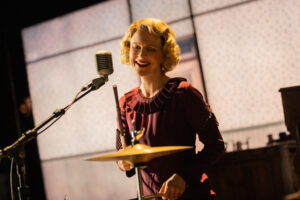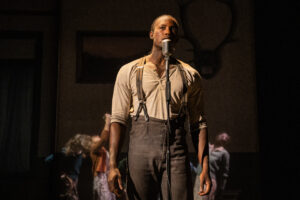
 *** Bob Dylan’s genius takes center stage in the touring production of “Girl from the North Country”, the latest Broadway in Chicago show to hit the CIBC Theatre. Filled with marvelous music and lyrics, this jukebox musical features twenty-two of Dylan’s songs written over five decades and highlights his signature song “Girl from the North Country” (1963). We hear “Like a Rolling Stone” (1965), “Forever Young” (1974), “Slow Train” (1979), “Pressing On” (1980), and “Make You Feel My Love” (1997) among others. In addition to the cast’s great singing voices, Simon Hale’s orchestrations, arrangements, and musical supervision add to the show’s excellence. Plus, the score is pleasingly executed, thanks to music director Timothy Splain.
*** Bob Dylan’s genius takes center stage in the touring production of “Girl from the North Country”, the latest Broadway in Chicago show to hit the CIBC Theatre. Filled with marvelous music and lyrics, this jukebox musical features twenty-two of Dylan’s songs written over five decades and highlights his signature song “Girl from the North Country” (1963). We hear “Like a Rolling Stone” (1965), “Forever Young” (1974), “Slow Train” (1979), “Pressing On” (1980), and “Make You Feel My Love” (1997) among others. In addition to the cast’s great singing voices, Simon Hale’s orchestrations, arrangements, and musical supervision add to the show’s excellence. Plus, the score is pleasingly executed, thanks to music director Timothy Splain.
Written and directed by Conor McPherson, “The Girl from the North Country” spins a tale that mostly takes place around Thanksgiving week in the year 1934. As a result of the Great Depression and a lack of finances, Nick Laine (John Schiappa) has turned his home into a guesthouse for travelers to Duluth, Minnesota, and for long-term community residents who need a place to live. We see his wife Elizabeth (in a superb performance by Jennifer Blood), who suffers from dementia and barely says a word. Then there is their son Gene (Ben Biggers), and their daughter Marianne (Sharaé Moultrie, with a gorgeous singing voice). Whereas Nick, Elizabeth, and Gene are white, Marianne is black and adopted.
The main thread of the story has to do with what it is like being one of the few black women in Minnesota when practically everybody else is white. Whereas the Laine family sees no differences in color, various lodgers may or may not be accepting of Marianne. For example, there is the elderly Mr. Perry (Jay Russell), who is paternalistic (if not outright obnoxious) when it comes to his marriage proposal. The only one who truly understands Marianne (and says as much) is Joe Scott (Matt Manuel), who is also black. Another thread has to do with how Nick subsequently wants to hook up with Ms. Neilson (Carla Woods), since his mentally deteriorating wife can no longer supply the love and devotion that he needs. Yet another thread has to do with Elias Burke (Aidan Wharton), who suffers from autism and stuttering; we watch how he changes for the better while in the company of others. These are just some examples of the many threads which combine to form the larger story.
A major problem with the show has to do with the fact that the audience must keep track of a large number of characters—seventeen in all—and follow too many subplots woven into the drama. In fact, the musical can be thought of as being a grittier and much less idyllic version of the TV program “The Love Boat.” We see numerous guests come together in one location at the beginning of the show and watch them interact with each other. Then by the end of the show, each person has changed in some way as they head for their respective destinations and their future lives. Other characters include Kate Draper (Chiara Trental Ange, who is also the dance and fight captain), Dr. Walker (Alan Ariano), Reverend Marlowe (Jeremy Webb), Mr. Burke (David Benoit), and Mrs. Burke (Jill Van Velzer). Soloists and the Ensemble are made up of Ashley D. Rooks, Justin Michael Duval, Kelly McCormick, and Hosea Mundi.
At the conclusion of the performance, the doctor addresses the audience. He has been our narrator throughout and has happened to have passed away during Christmas week of 1934. From his perspective in the afterlife, he now tells us how the Laine family fits in within the tide of history. He reminisces about what the family was like when it was a cohesive foursome prior to the Great Depression and before Elizabeth had dementia. Although times seemed happier back then, the introduction of new and widely different lodgers made each of the characters learn something about life and love. In so doing, they came to a whole host of realizations about themselves.
Rae Smith, who is both the scenic and costume designer, has done a nice job depicting the 1930s: both through apparel and a series of projections of black and white photographs of small town and rural areas. The scrims are done particularly well. Lighting by Mark Henderson is good. The sound system is better in the second act: probably a matter of a somewhat revamped sound design between sets.
In sum, the production is largely a mashup of popular favorites with a storyline placed on top of it. Fine performers in major and minor roles sing a wealth of Dylan songs that cover lots of different styles. I particularly enjoyed the numbers that include a chorus of women standing in a circle. The singing and dialogue are complimented by number of soliloquies interspersed throughout, many of which are reflections on life, such as wanting companionship, being in love, getting older, and so forth. But when too many characters are introduced, the underlying story becomes hard to follow. When the audience has to figure out each song’s context within the plot or subplot, it becomes difficult to enjoy each song on its own merits. Despite this drawback, the performance is very good—and, of course, the songs themselves are superb—which makes the musical highly entertaining no matter what.
“Girl from the North Country” is playing at CIBC Theatre, 18 W Monroe St, Chicago, through February 25, 2024.
Tickets: $31.50 -$125.50
Performance schedule:
 Tuesdays, Wednesdays, and Thursdays – 7:00 p.m.
Tuesdays, Wednesdays, and Thursdays – 7:00 p.m.
Fridays – 7:30 p.m.
Saturdays – 2:00 p.m. and 7:30 p.m.
Sundays – 1:00 p.m.
Additional performances:
Sunday, February 18th at 6:30 p.m.
Wednesday, February 21st at 1:00 p.m.
For more information about Broadway in Chicago’s production and to purchase tickets, go to:
https://www.broadwayinchicago.com/shows/girl-from-the-north-country/.
For detailed information where and when the show is touring, please visit: https://northcountrytour.com/.
To see what others are saying, visit www.theatreinchicago.com, go to Review Round-Up and click at ” Girl From The North Country”.






More Stories
“The Magic School Bus: Lost in the Solar System”
“February House” reviewed by Julia W. Rath
” A Lie of The Mind”